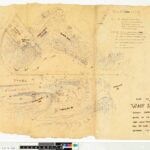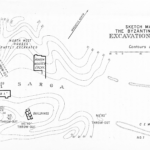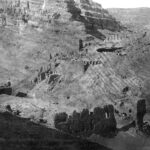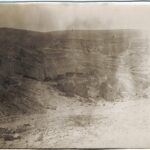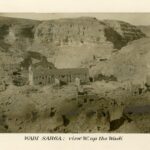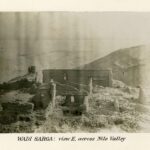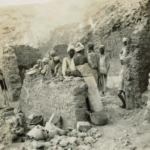WĀDĪ SARǦA (APA THŌMAS MONASTĒRION)
| Greek | Ἄπα Θωμᾶς μοναστήριον |
| Coptic | monasthrion napa cwmas | petra napa cwmas |
| Arabic | وادي سرجة |
| English | Wadi Sarga |
| French | Ouadi Sarga |
| DEChriM ID | 32 |
| Trismegistos GeoID | 12542 |
| Pleiades ID | 759543 | PAThs ID | 91 |
| Ancient name | Apa Thōmas monastērion |
| Modern name | Wādī Sarǧa |
| Latitude | 26.931111 |
| Longitude | 31.281111 |
| Date from | - |
| Date to | - |
| Typology | Monastic settlement |
| Dating criteria | - |
| Description | Wādī Sarğa is situated in a wadi about 25km south of Asyut, situated on the west bank of the Nile near Dayr al-Balāyza. Today, the area is off-limits, as it has been converted into a military zone. Consequently, understandings of the site are dependent on descriptions and plans made by explorers and archaeologists during the early and mid-20th century. R. C. Thompson, who led excavations of the site, describes the presence of large buildings and numerous small ‘houses’ situated on the flanks of the wadi (Thompson 1922: 2, 4). Along the southern ridge, at a higher elevation than most of the buildings, numerous rock-cut spaces were investigated, including the so-called Rock-Church (O’Connell 2014: 130-131). This church is situated in a former quarry and, like many other rock-cut areas of the site, included painted depictions of religious scenes. The ones here, however, are the most elaborate of the whole site, and were depicted in a 1920 watercolour by C. O. Waterhouse. Based on the textual documents retrieved during fieldwork at the site, comprising papyri, ostraca and stelae, much of which was found in the middens dotted throughout the area, the site was determined to have been home to a monastic community, known as the monastery of Apa Thomas (Crum and Bell 1922: 6-7; P. Sarga 164). As well as the numerous mud-brick buildings, and rock-cut areas, the site is host to three cemeteries (Faiers 2014: 178). ‘Cemetery 1’ is located in the mouth of the Wadi and is understood to have been the cemetery that served the monastic community. ‘Cemetery 2’, which included some 20-30 graves, was said to be within view of the 19th century church at Deir el-Ganadleh, ‘Cemetery 3’ is a Greco-Roman necropolis said to be situated a few hundred meters south of the modern village of Ganadleh. The latter was discovered by two local tomb robbers employed during excavations to help identify cemeteries, which was a key focus of mission. While searching for additional graves, these men uncovered the so-called ‘Daniel Villa’, situated some 3km north of Wadi Sarga. This structure is host to painted depictions of the three Hebrews in the fiery furnace from the Book of Daniel (3.19-30), and the saints Cosmas and Damian and their three brothers (Thompson 1933: 5; O’Connell 2014: 133). A comprehensive understanding of the chronological development of the site is lacking. It is known, however, that the area operated as a quarry from as early as the Old Kingdom (Klemm and Klemm 1993: 153). Additionally, a stone relief, which has been attributed to the Ptolemaic or early Roman period, attests to occupation at this time, which is further attested to by the cemeteries. Occupation of the monastery appears to have spanned from the mid-fifth to the eighth-ninth centuries, based on analysis of the ceramic material retrieved during the 1913-1914 mission (Faiers 2014: 180; O’Connell 2014: 123). Details of the site are somewhat unclear, with limited capacity to resolve various uncertainties due to the lack of accessibility in modern times. For a discussion of the confusion surrounding a number of specifications of distances between features and names attributed to different areas of the site, see: O’Connell 2014: 124-125. A great deal of information is able to be retrieved, however, based on the various objects retrieved during excavation work and the associated excavation documentation, which is today being studied as part of the research project titled ‘Wadi Sarga at the British Museum’. A total of six plans were produced during excavations of six mud-brick structures situated on the north and south flanks of the wadi, as well as numerous water colours of the paintings in the rock-cut areas. A topographical map was made by F. A. Richard, but was never published, and its whereabouts today remains a mystery. Thompson included a map in his brief description of the site from 1922, which was based on a sketch map he had made previously based on Richard’s map, using his scale, baseline and triangulation points (O’Connell 2014: 128). With the help of these maps, many of the architectural units that were excavated have today been geo-referenced. |
| Archaeological research | The site was visited by numerous figures during the 20th century who published brief accounts of their visits, such as S. J. M. Julien (Julien 1903: 239-240) and S. Clarke (Clarke 1912: 174-175). Petrie visited the site in 1907 whilst investigating numerous other Christian settlements in the area (Petrie 1907: 2, 30 and plates 39 and 40). Fathers Michel Jullien and Maurice Martin S. J visited the site and took a number of photographs, which are now in the Collège de la Sainte Famille in Cairo. Jean Doresse also photographed the site, and made a number of sketches and plans (Doresse 2000, 4: 360-410, 5: 612 and 636-659). Archaeological exploration of the site was initiated by O. M. Dalton, who was the British Museum’s Byzantinist. After failing to obtain the concession of Bawit, he commissioned Egyptologist T. E. Peet to seek a suitable site for excavation, preferably including a cemetery (O’Connell 2014: 126). Peet suggested Deir el-Ganadleh, which he came to refer to as Wadi Sarga. After being granted the concession, the archaeologist and Assyriologist Reginald Campbell Thompson was employed to lead excavations, given that Dalton himself was not an archaeologist. Fieldwork at the site began November 16th, 1913 and lasted until January 28th, 1914. The official site report was never published due to the outbreak of the first world war, but a brief summary of two pages was distributed in the Journal of Egyptian Archaeology (Thompson 1914a: 187-188). Additional information concerning the site was published by Thompson in a 1922 volume regarding the written material uncovered during the fieldwork (Thompson 1922: 1-5). Considering the fact that the area is now off-limits, subsequent works on the site have relied almost exclusively on these descriptions provided by Thompson. |
• Brooks Hedstrom, D. L. 2017. The Monastic Landscape of Late Antique Egypt. Cambridge: Cambridge University Press.
• Cappozzo, M. 2007. ”Uadi Sarga.” In Il cristianesimo nel Medio Egitto. Todi: Tau. 139-142.
• Clarke, S. 1912. Christian Antiquities in the Nile Valley: A Contribution Towards the Study of the Ancient Churches, 174. Oxford: Clarendon Press.
• Coquin, R.-G. and M. Martin. 1991. ”Wadi Sarjah.” In The Coptic Encyclopedia, Vo. 7, edited by A. S. Atiya, 2312. New York: Macmillan.
• Cromwell, J. 2013. ”A Coptic Epistolary Exercise from Wadi Sarga.” Journal of Egyptian Archaeology 99: 272-275.
• Cromwell, J. 2014. ”The Textual Corpus from Wadi Sarga: A New Study.” In British Museum Newsletter: Egypt and Sudan 1: 17.
• Crum, W. E. and H. I. Bell, eds. 1922. Wadi Sarga: Coptic and Greek Texts from the Excavations Undertaken by the Byzantine Research Account. Copenhagen: Gyldendal.
• Dalton, O. M. 1916. ”A Coptic Wall-Painting from Wadi Sarga.” Journal of Egyptian Archaeology 3: 35–37.
• Dekker, R. 2015. ”The Monastery of Apa Thomas at Wadi Sarga: Point of Departure for a Relative Chronology.” In Christianity and Monasticism in Middle Egypt: Al-Minya and Asyut, edited by G. Gabra and H. N. Takla, 1–13. Cairo: The American University in Cairo Press.
• Doresse, J. 1952. ”Découverte d’une nouvelle église peinte.” Comptes rendus de l'Académie des Inscriptions et Belles-Lettres 96, 3: 390.
• Doresse, J. 1970. ”Monastères coptes de Moyenne Égypte.” Bulletin de la Société française d'égyptologie 59: 7-29.
• Doresse, J. 2000. Les anciens monastères coptes de Moyenne-Égypte (du Gebel-et-Teir à Kom-Ishgaou) d'après l'archéologie et l'hagiographie, 3 vols. Yverdon-les-Bains: Institut d'archéologie yverdonnaise.
• Drioton, E. 1944. ”Un dessin copte des trois Hébreux dans la fournaise.” Bulletin de la Société d'archéologie copte 10: 80-85.
• Faiers, J. 2014. ”Wadi Sarga Revisited: A Preliminary Study of the Pottery Excavated in 1913/14.” In Egypt in the First Millennium AD: Perspectives from New Fieldwork, edited by E. O'Connell, 177-189. Leuven: Peeters.
• Leclercq, H. 1954. ”Wadi Sarga.” In Dictionnaire d’archéologie chrétienne et de liturgie, edited by F. Cabrol and H. Leclercq, vol. 15.2, col. 3237. Paris: Letouzey et Ané.
• Meinardus, O. F. A. 1965. Christian Egypt: Ancient and Modern. Cairo: Cahiers d’histoire égyptienne. 288–289.
• O’Connell, E. R. 2007. ”Transforming Monumental Landscapes in Late Antique Egypt.” In Holy Households: Domestic Space, Property and Power, edited by K. Sessa, Journal of Early Christian Studies 15: 239-274.
• O’Connell, E. R. 2012. ”Settlements and Cemeteries of Late Antique Egypt: A Short History of Archaeological Collections in the British Museum.” In Coptic Culture: Past, Present and Future, edited by M. Ayad, 102-103. Oxford: Oxbow Books.
• O'Connell, E. R. 2014. ”R. Campbell Thompson’s 1913/14 Excavation of Wadi Sarga and Other Sites.” British Museum Studies in Ancient Egypt and Sudan 21: 121-192.
• Petrie, W. M. Flinders. 1907. Gizeh and Rifeh. London: School of Archaeology in Egypt. 2, 30 and pls. 39, 40.
• Petrie, W. M. Flinders. 1909. Memphis I. London: School of Archaeology in Egypt. pl. 54.
• Porter, B. and R. L. B. Moss. [1937] 1962. Topographical Bibliography of Ancient Egyptian Hieroglyphic Texts, Reliefs and Paintings V: Upper Egypt. Sites. Repr. Oxford: Griffith Institute.
• Smart, T. 2018. “Commemorating the Dead: A Study of the Stelae Discovered at Wadi Sarga.” MA dissertation, King's College London.
• Strudwick, N. 2006. Masterpieces of Ancient Egypt. London: British Museum Press. 324-5 (EA 73139) and 326-7 (EA 73196).
• Thompson, H. 1911. A Coptic Palimpsest Containing Joshua, Judges, Ruth, Judith and Esther in the Sahidic Dialect. London, New York: Oxford University Press.
• Thompson, R. C. 1914a. “Byzantine Research Fund: Excavations at Wadi Sarga.” Journal of Egyptian Archaeology 1: 187-188.
• Thompson, R. C. 1914b. “An Egyptian Relief at Wadi Sarga.” Proceedings of the Society of Biblical Archaeology 36: 198.
• Thompson, R. C. 1922. “Introduction I: The Excavations at Wadi Sarga.” In Wadi Sarga: Coptic and Greek Texts from the Excavations Undertaken by the Byzantine Research Account, edited by W. E. Crum and H. I. Bell, 1-5. Copenhagen: Gyldendal.
• Timm, S. ed. 1984-1992. Das christlich-koptische Ägypten in arabischer Zeit: Eine Sammlung christicher Stätten in Ägypten in arabischer Zeit unter Ausschluß von Alexandria, Kairo, des Apa-Mena-Klosters (Dēr Abū Mina), der Skētis (Wādi n-Naṭrūn) und der Sinai-Region. Vol. 3, 1400-1403. Wiesbaden: Dr Ludwig Reichert.
• Tudor, B. 2011. Christian Funerary Stelae of the Byzantine and Arab Periods from Egypt. Marburg: Tectum Verlag. 75, 188-195, 203-204, 230, 414-415, inter alia.
• Wipszycka, E. 2009. Moines et communautés monastiques en Égypte (IVe-VIII siècles). Warsaw: Journal of Juristic Papyrology. 90, 155–57, 330, 361, 457, 546, 549–550.


 Json data
Json data